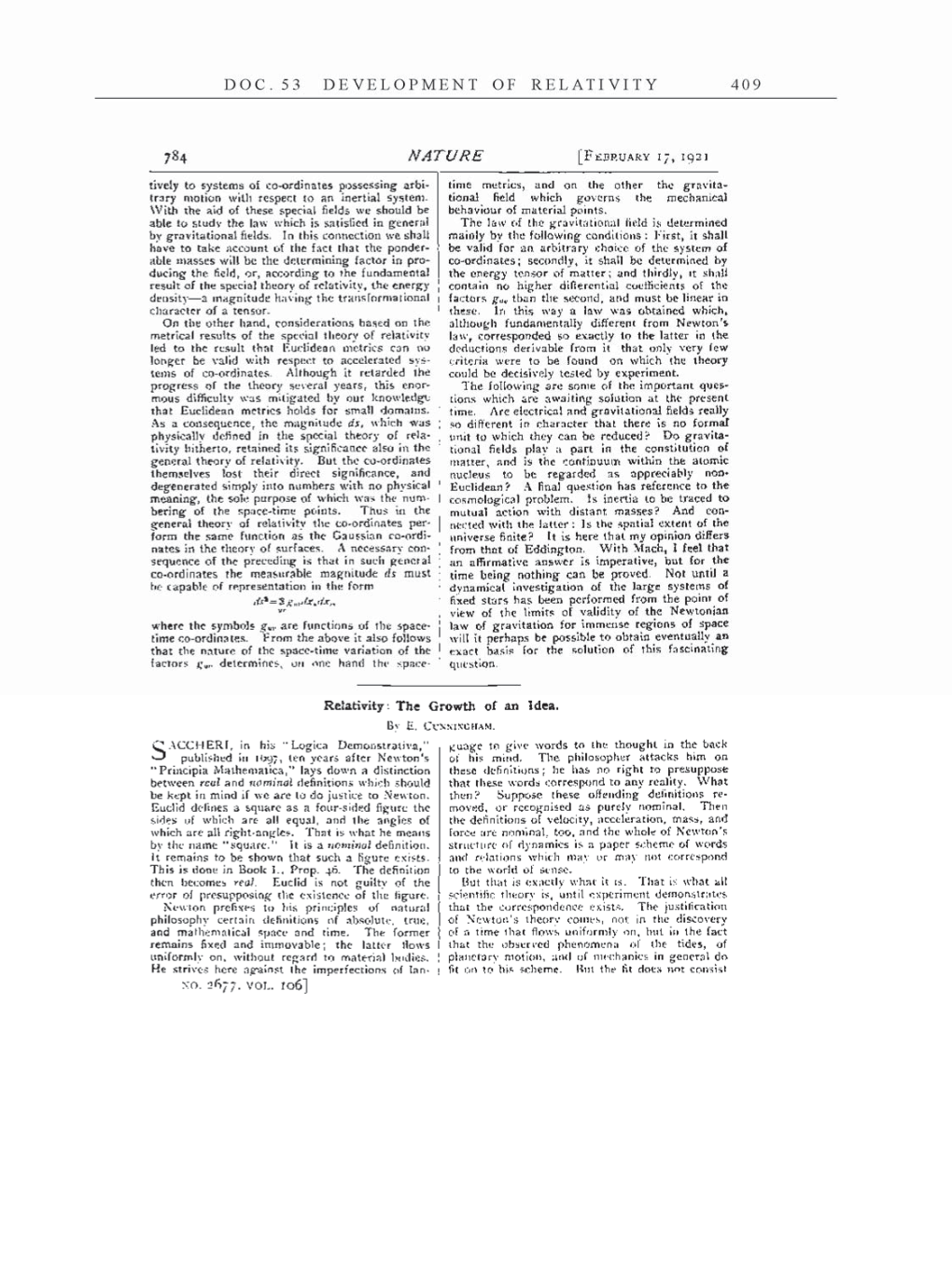DOC.
53
DEVELOPMENT OF RELATIVITY 409
784
NATURE
[February
17,
1921
tively to systems of
co-ordinates
possessing arbi-
trary motion with
respect to
an
inertial
system.
With the aid
of
these
special
fields
we
should be
able
to
study the
law
which
is
satisfied
in general
by
gravitational
fields.
In this connection
we
shall
have
to
take account
of the fact that the ponder-
able masses
will
be the
determining
factor in pro-
ducing the
field, or,
according to
the fundamental
result of the
special theory
of
relativity,
the
energy
density-a
magnitude having
the transformational
character of
a
tensor.
On the other
hand,
considerations based
on
the
metrical results of the
special theory
of
relativity
led to
the result that Euclidean metrics
can no
longer
be
valid with
respect to
accelerated sys-
tems of co-ordinates.
Although
it retarded the
progress
of the
theory
several
years,
this enor-
mous difficulty was mitigated
by
our knowledge
that Euclidean metrics
holds for small domains.
As
a
consequence,
the
magnitude
ds,
which
was
physically
defined
in
the
special theory
of rela-
tivity hitherto,
retained its
significance
also in
the
general
theory
of
relativity.
But the co-ordinates
themselves lost their direct
significance,
and
degenerated simply
into numbers with
no
physical
meaning,
the sole
purpose
of which
was
the num-
bering of the
space-time points.
Thus
in
the
general theory of relativity
the co-ordinates per-
form the
same
function
as
the Gaussian co-ordi-
nates
in
the
theory
of
surfaces. A
necessary con-
sequence of the
preceding
is
that
in
such
general
co-ordinates the measurable
magnitude
ds must
be
capable
of
representation in
the form
dx2=3Rvrguvdx1dx2
where the
symbols
guv
are
functions
of
the space-
time co-ordinates.
From the above it also
follows
that the
nature
of the
space-time
variation
of
the
factors
guv
determines,
on one
hand the space-
time
metrics,
and
on
the other the gravita-
tional
field
which
governs
the mechanical
behaviour of material
points.
The
law
of the
gravitational
field
is determined
mainly
by
the
following
conditions:
First,
it shall
be
valid for
an arbitrary
choice of the
system
of
co-ordinates;
secondly,
it shall
be
determined
by
the
energy tensor
of
matter;
and
thirdly, it
shall
contain
no
higher
differential coefficients of
the
factors
guv
than the
second,
and
must
be
linear in
these. In this
way
a
law
was
obtained
which,
although fundamentally
different from Newton’s
law, corresponded
so
exactly to
the latter
in
the
deductions derivable from
it
that
only
very few
criteria
were
to
be found
on
which the
theory
could
be
decisively
tested
by
experiment.
The
following
are some
of the
important ques-
tions which
are
awaiting
solution at the
present
time. Are electrical and
gravitational
fields
really
so
different
in
character that there is
no
formal
unit
to
which
they can
be
reduced? Do
gravita-
tional fields
play a
part in
the constitution of
matter, and
is the continuum within
the
atomic
nucleus to
be
regarded as
appreciably non-
Euclidean?
A final question
has reference
to
the
cosmological
problem.
Is inertia to
be traced
to
mutual action with distant masses? And
con-
nected with the
latter
: Is the
spatial
extent
of the
universe finite? It is here that
my opinion
differs
from that of
Eddington.
With Mach,
I
feel that
an
affirmative
answer
is
imperative,
but for
the
time
being nothing can
be
proved.
Not until
a
dynamical investigation
of the
large systems
of
fixed stars
has been
performed
from the
point
of
view
of
the limits of
validity
of the Newtonian
law of
gravitation
for immense
regions
of
space
will it perhaps
be
possible
to
obtain
eventually an
exact
basis
for the solution of this
fascinating
question.
Relativity:
The Growth of
an
Idea.
By
E.
Cunningham.
SACCHERI,
in
his
"Logica Demonstrativa,"
published
in
1697,
ten
years
after
Newton's
"Principia Mathematica,"
lays
down
a
distinction
between
real
and
nominal definitions
which should
be
kept
in
mind
if
we are to
do
justice to
Newton.
Euclid defines
a
square
as
a
four-sided
figure
the
sides
of
which
are
all
equal,
and the
angles
of
which
are
all right-angles.
That
is
what he
means
by
the
name
"square." It
is
a
nominal definition.
It remains
to
be shown that such
a figure
exists.
This is done
in
Book
1., Prop.
46.
The definition
then becomes real. Euclid
is not
guilty
of
the
error
of
presupposing
the existence of the
figure.
Newton
prefixes to
his
principles
of natural
philosophy
certain definitions of
absolute
true,
and mathematical
space
and time. The former
remains
fixed
and immovable; the latter
flows
uniformly on,
without
regard to
material
bodies.
He strives here
against
the
imperfections
of lan-
NO. 2677, VOL.
106]
guage to give
words
to
the
thought in
the back
of
his
mind. The
philosopher
attacks
him
on
these
definitions; he
has
no
right
to
presuppose
that
these words
correspond
to any reality.
What
then?
Suppose
these
offending
definitions
re-
moved, or
recognised as purely
nominal. Then
the definitions of
velocity,
acceleration,
mass,
and
force
are
nominal, too,
and the whole of Newton’s
structure
of
dynamics
is
a paper
scheme of words
and relations
which
may or may
not
correspond
to
the world of
sense.
But
that
is exactly
what
it is.
That is
what
all
scientific
theory
is,
until
experiment
demonstrates
that the
correspondence
exists. The
justification
of
Newton’s
theory comes, not in
the
discovery
of
a
time that flows
uniformly on,
but
in
the fact
that the observed
phenomena
of the
tides,
of
planetary
motion,
and of mechanics
in
general
do
fit on to
his scheme.
But the fit does
not
consist
